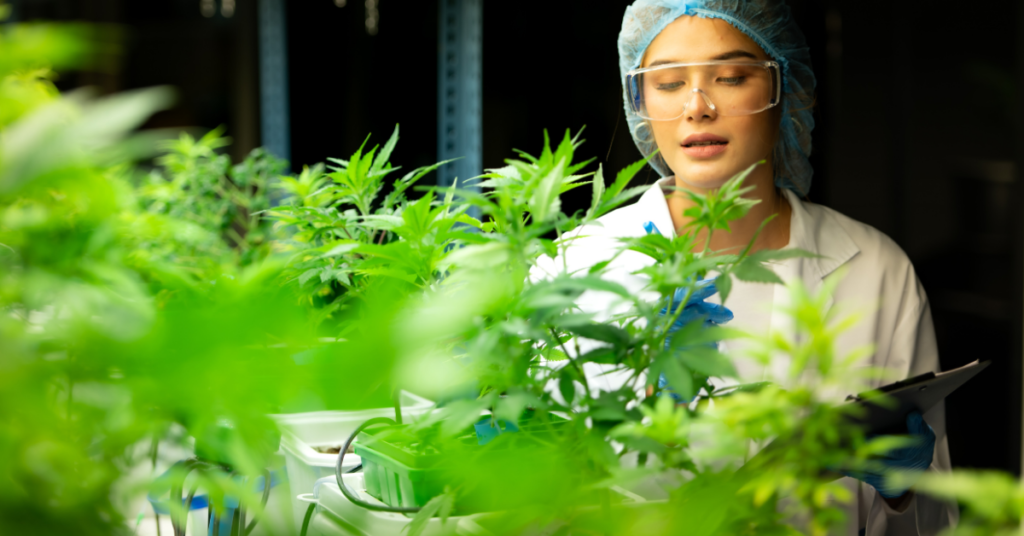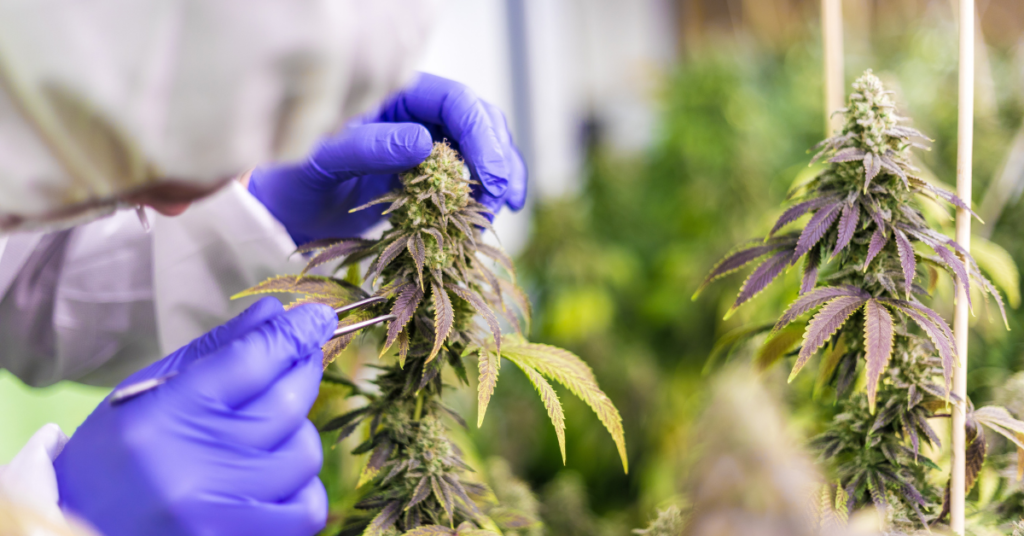The world of cannabis cultivation is a fascinating one, brimming with unique phenomena and unexpected challenges.
Among these, one particular occurrence that intrigues, puzzles, and often alarms growers is the formation of “cannabis foxtails”.
This article delves deep into the realm of cannabis foxtails, exploring what they are, what triggers their formation, their impact on the overall cannabis yield, and how growers can effectively manage them.
Table of Contents
What are foxtails on cannabis?
Cannabis foxtails refer to an unusual growth pattern exhibited by cannabis flowers or buds, wherein they develop into elongated, irregular structures that bear an uncanny resemblance to a fox’s tail.
The transformation of a typically round, dense cannabis bud into a slender, lopsided flower is a startling sight for any grower.
This shape-shifting can occur due to various factors, including environmental stress, genetic predisposition of the cannabis strain, or even a combination of both.
Unraveling the Genetics Behind Cannabis Foxtailing
The inherent genetic makeup of certain cannabis strains can make them more susceptible to foxtailing.
This phenomenon is particularly prevalent in some heirloom sativa strains, where the foxtailing trait has been stabilized through selective breeding.
It’s worth noting that not all foxtailing is a sign of stress or an issue with cultivation practices. Some cannabis breeders deliberately stabilize the foxtailing trait to cater to a niche demand from growers who appreciate this unique aesthetic.
In some cases, growers cultivate foxtailing strains to add an intriguing and offbeat twist to their cannabis garden.
Types of Cannabis Foxtails
There are two main types of cannabis foxtails:
Genetic Foxtailing
Some strains of cannabis naturally grow foxtailed buds due to their genetics. This form of foxtailing is not a cause for concern; it’s just how that particular strain grows.
Environmental Foxtailing
This form of foxtailing is caused by environmental stress. When cannabis plants are subjected to certain conditions, they may respond by developing foxtails. Common stressors include:
How to Spot Cannabis Foxtails

Cannabis cultivation can be a meticulous process, requiring keen observation and attention to detail.
Among the many nuances of growing, spotting the presence of foxtails on cannabis plants is crucial. Foxtailing, an abnormal growth pattern on cannabis buds, can indicate stress in the plant. But how do you identify them?
Identifying Cannabis Foxtails
To understand how to spot cannabis foxtails on cannabis, one must first know what they look like.
Instead of the regular rounded and dense structure that most buds form, a foxtailed bud will present spires or elongated pillars of calyxes stacking on top of one another.
These formations look a lot like the tail of a fox, thus the name ‘foxtails’.
Shape: Regular cannabis buds tend to be compact and rounded, forming a chunky or nugget-like shape. In contrast, cannabis foxtails will have protruding, spire-like growths. These growths can sometimes appear as towers or spears rising from the main bud or as distinct elongated tips scattered throughout the bud structure.
Density: Because of this elongated growth pattern, buds with foxtails may feel less dense or solid when you touch them. The extra growth can lead to a more airy bud structure, especially if the foxtailing is caused by environmental stresses.
Distribution: You might notice that not all parts of the plant are affected. Foxtails on cannabis can be localized, particularly if caused by specific environmental stressors like a hotspot from a grow light.
What Causes Foxtails on Cannabis?
It’s essential to differentiate between genetic and environmental foxtailing.
Some strains are naturally predisposed to grow foxtailed buds. In these cases, the cannabis foxtails are simply a unique genetic trait and not a cause for concern.
However, environmental stressors such as high temperatures, light stress, or certain chemicals can also induce this abnormal growth pattern.
Why is it Important to Spot Foxtails?
While genetic foxtailing doesn’t harm the plant, environmental foxtailing is a sign of stress.
Continued stress can compromise the health of your cannabis plants and potentially reduce the quality of your final product in terms of potency, flavor, and aroma.
The Impact of Environmental Stress on Foxtailing

While genetics play a significant role, environmental conditions are often the primary culprits behind the occurrence of cannabis foxtails. Key environmental factors that can induce foxtailing include:
Light Stress
Inappropriate lighting conditions can wreak havoc on cannabis plants and trigger the development of foxtails.
If your grow lights are too intense, positioned too closely to the buds, or generate excessive heat, it can lead to light stress and the subsequent formation of foxtails.
Heat Stress
Cannabis plants thrive in consistently warm temperatures. However, if the temperature in the grow room or outdoor garden exceeds the optimal range for an extended period, it can lead to heat stress and potentially induce foxtailing.
Root Zone Health
The health of the root zone, though not visible to the naked eye, can significantly impact the overall health and development of cannabis plants.
Adverse conditions in the root zone, such as improper pH levels or harmful microbial activity, can cause plant stress and may lead to foxtails.
How to Prevent Cannabis Foxtails
This atypical bud formation can alter the aesthetic appeal of your harvest and may indicate unfavorable growing conditions.
However, with some care and observation, preventing foxtails in cannabis can be straightforward. Here’s how:
Control the Temperature
One of the most common causes of foxtails in cannabis is prolonged exposure to high temperatures. It’s essential to keep your grow space’s temperature in the optimal range, typically between 68°F (20°C) and 77°F (25°C). Especially during the flowering phase, temperatures above 80°F (27°C) can lead to foxtailing.
Ensure Proper Lighting
Light stress, especially from powerful lights placed too close to the plant canopy, can cause foxtails. Ensure you have the right distance between your lights and plants. Additionally, make sure the light distribution is even, preventing hotspots or areas of concentrated light intensity.
Use Suitable Light Types
The type of light can influence the growth of cannabis. While most modern grow lights are designed to support cannabis growth without causing foxtails, it’s essential to ensure that the light spectrum you’re using is appropriate for your cannabis plants.
Limit Plant Growth Regulators and Pesticides
Some chemicals, when applied excessively or late in the flowering stage, can encourage foxtails in cannabis. Always be cautious about the products you use and follow recommended dosages and application times.
Choose the Right Genetics
Some strains naturally produce foxtails due to their genetics. If you’re growing in an environment prone to temperature fluctuations or light stress, opt for strains that are less likely to develop foxtails under these conditions.
Provide Consistent Environment
Avoid any sudden changes in your grow environment. Fluctuations in temperature, light, or humidity can stress the plant and increase the chances of developing foxtails.
Monitor Plant Health
Regularly check your plants for signs of stress or disease. A healthy cannabis plant is less likely to develop foxtails than a stressed or diseased one. Regular inspections can help you catch and address issues early.
Are Cannabis Foxtails Bad?
Cannabis foxtails, characterized by elongated, spire-like growths on buds, can be a concern for growers. But are they truly bad?
Genetic vs. Environmental: Not all foxtails are a sign of trouble. Some strains naturally produce foxtailed buds due to genetics. In such cases, the foxtails are harmless. However, environmental foxtails, caused by stressors like high temperatures or light stress, can indicate issues in the growing environment.
Potency and Quality: While the presence of foxtails doesn’t necessarily diminish the potency, environmental stress that causes foxtailing can affect overall bud quality, flavor, and aroma.
Aesthetic Appeal: For some, cannabis foxtails may reduce the visual appeal of the buds, making them less marketable or less pleasing for personal use.
Harvesting Foxtailing Buds
Even if your cannabis plants develop foxtails, you can still harvest and enjoy their flowers.
Monitor the color of your trichomes to determine the right time to harvest. Once the trichomes turn from clear to cloudy, it’s usually a good time to harvest your foxtailing buds.
Parting Remarks on Cannabis Foxtails
Cannabis foxtails can be a cause of concern for growers, especially those new to cannabis cultivation.
However, understanding what they are, what causes them, and how to manage them can mitigate their impact on your overall yield and ensure a successful harvest. Remember, not all foxtailing is bad, and in some cases, it can even add a unique touch to your cannabis garden.
Cultivating cannabis is a journey filled with surprises and challenges. Foxtailing is just one of them.
By equipping yourself with the right knowledge and cultivation practices, you can turn these challenges into opportunities for learning and growth.
Happy growing!
